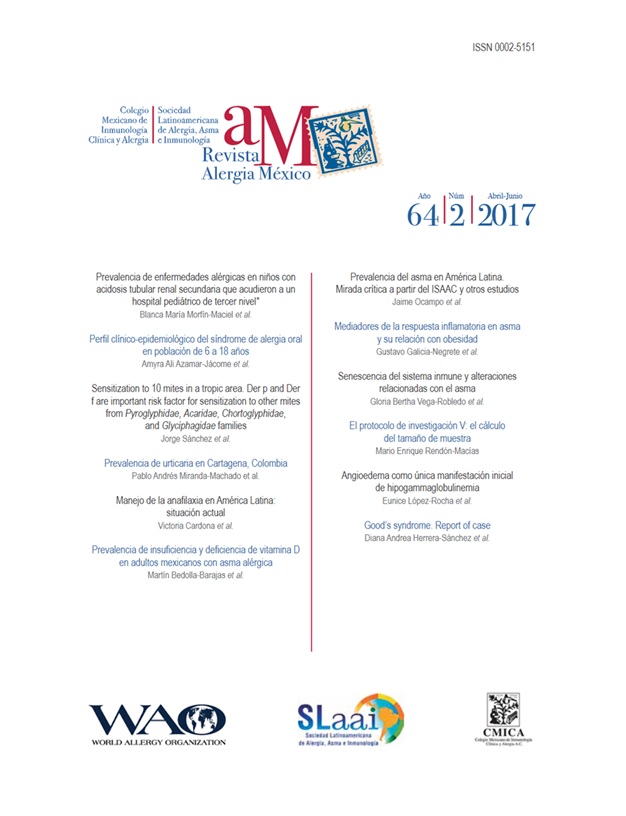Resumen
Antecedentes: Los ácaros son la principal fuente de sensibilización en el trópico. Aunque se conoce mucho sobre la frecuencia de sensibilización a Blomia tropicalis, Dermatophagoides pteronyssinus y Dermatophagoides farinae, se conoce menos sobre la sensibilización a otras especies y sus posibles interacciones.
Objetivo: Evaluar en pacientes con enfermedades alérgicas, la frecuencia de sensibilización a 10 especies de ácaros en un área tropical y sus posibles interacciones.
Métodos: Estudio trasversal en el que se evaluó la sensibilización mediante pruebas cutáneas. Para evaluar la relación entre la sensibilización a los diferentes ácaros se utilizó un modelo lineal generalizado de regresión de Poisson. Con base en las razones de sensibilización y los análisis de redes sociales, se exploró la relación entre los 10 ácaros.
Resultados: Se incluyeron 147 pacientes. La mayor frecuencia fue encontrada para los ácaros de la familia Pyroglyphidae (>70%) y los de menor frecuencia, la familia Glycyphagidae (<50%). La sensibilización a cualquier ácaro incrementaba el riesgo de sensibilización a los otros. La sensibilización a Der f o Der p incrementaba más de 20 veces la probabilidad de sensibilización a ácaros de la familia Pyroglyphidae y 10 a 20 veces a ácaros de otras familias. La sensibilización a ácaros de la familia Glycyphagidae, Chortoglyphidae or Acaridae también incrementaba el riesgo menos de 5 veces.
Conclusión: La sensibilización a ácaros es frecuente en el trópico. La sensibilización a ácaros Pyroglyphidae es el principal factor de riesgo para la polisensibilización a ácaros de la familia Glycyphagidae, Chortoglyphidae o Acaridae. Estos resultados deben ser tenidos en cuenta al momento de definir el diagnostico y tratamiento de las enfermedades alérgicas.
Referencias
Chong Neto HJ, Rosário NA, Solé D; Latin American ISAAC Group. Asthma and rhinitis in South America: How different they are from other parts of the world. Allergy Asthma Immunol Res. 2012;4(2):62-67. DOI: http://dx.doi.org/10.4168/aair.2012.4.2.62
Solé D, Mallol J, Wandalsen GF, Aguirre V; Latin American ISAAC Phase 3 Study Group.. Prevalence of symptoms of eczema in Latin America: results of the International Study of Asthma and Allergies in Childhood (ISAAC) Phase 3. J Investig Allergol Clin Immunol. 2010;20(4):311-323. Available from: http://www.jiaci.org/summary/vol20-issue4-num605
Kurukulaaratchy RJ, Karmaus W, Arshad SH. Sex and atopy influences on the natural history of rhinitis. Curr Opin Allergy Clin Immunol. 2012;12(1):7-12. DOI: http://dx.doi.org/10.1097/ACI.0b013e32834ecc4e
Fasce L, Tosca MA, Baroffio M, Olcese R, Ciprandi G. Atopy in wheezing infants always starts with monosensitization. Allergy Asthma Proc. 2007;28(4):449-453.
Bousquet J, Heinzerling L, Bachert C, Papadopoulos NG, Bousquet PJ, Burney PG, et al. Practical guide to skin prick tests in allergy to aeroallergens. Allergy. 2012;67(1):18-24. DOI: http://dx.doi.org/10.1111/j.1398-9995.2011.02728.x
Zakzuk J, Acevedo N, Cifuentes L, Bornacelly A, Sánchez J, Ahumada V, et al. Early life IgE responses in children living in the tropics: A prospective analysis. Pediatr Allergy Immunol. 2013;24(8):788-797. DOI: http://dx.doi.org/10.1111/pai.12161
Sánchez J, Diez S, Cardona R. [Frequency of sensitization to animals in a tropical area]. Rev Alerg Mex. 2014;61(2):81-89. Available from: http://revistaalergia.mx/ojs/index.php/ram/article/view/30
Burbach G, Heinzerling L, Edenharter G, Bachert C, Bindslev-Jensen C, Bonini S, et al. GA(2)LEN skin test study II: clinical relevance of inhalant allergen sensitizations in Europe. Allergy. 2009;64(10):1507-1515. DOI: http://dx.doi.org/10.1111/j.1398-9995.2009.02089.x
Martínez J, Méndez C, Talesnik E, Campos E, Viviani P, Sánchez I. [Skin prick test of immediate hypersensitivity in a selected Chilean pediatric population sample]. Rev Med Chil. 2005;133(2):195-201. DOI: http://dx.doi.org/10.4067/S0034-98872005000200007
Caraballo L, Puerta L, Fernández-Caldas E, Lockey RF, Martínez B. Sensitization to mite allergens and acute asthma in a tropical environment. J Investig Allergol Clin Immunol. 1998;8(5):281-284.
Hossny E, El-Sayed S, Abdul-Rahman N. Sensitivity to Five types of house dust mite in a group of allergic Egyptian children. Pediatr Allergy Immunol Pulmonol. 2014;27(3):133-137. DOI: Pediatr Allergy Immunol Pulmonol. 2014;27(3):133-137. DOI: http://dx.doi.org/10.1089/ped.2014.0333
Puerta L, Fernández-Caldas E, Lockey RF, Caraballo LR. Mite allergy in the tropics: sensitization to six domestic mite species in Cartagena, Colombia. J Investig Allergol Clin Immunol. 1993;3(4):198-204.
Sanchez J, Diez S, Cardona R. Sensibilización a aeroalergenos en pacientes alérgicos de Medellín, Colombia Rev Alergia Mex. 2012;59(3):139-147.
Brozek JL, Bousquet J, Baena-Cagnani CE, Bonini S, Canonica GW, Casale TB, et al. Allergic rhinitis and its impact on asthma (ARIA) guidelines: 2010 revision. J Allergy Clin Immunol. 2010;126(3):466-476. DOI: http://dx.doi.org/10.1016/j.jaci.2010.06.047
Sánchez J, Páez B, Macías A, Olmos C, de Falco A. [Atopic dermatitis guideline. Position paper from the Latin American Society of Allergy, Asthma and Immunology]. Rev Alerg Mex. 2014;61(3):178-211. Available from: http://revistaalergia.mx/ojs/index.php/ram/article/view/43
Heinzerling LM, Burbach GJ, Edenharter G, Bachert C, Bindslev-Jensen C, Bonini S, et al. GA(2)LEN skin test study I: GA(2)LEN harmonization of skin prick testing: novel sensitization patterns for inhalant allergens in Europe. Allergy. 2009;64(10):1498-1506. DOI: http://dx.doi.org/10.1111/j.1398-9995.2009.02093.
Dekker H. Asthma and mites. J Allergy Clin Immunol. 1971;48(4):251-252.
Voorhorst R, van der Hooft-van Asbeck MC, van Krieken H, Nikkels AH. Atopic skin test re-evaluated. V. The wheal-flare ratio of skin reactions to extracts of grass pollen, Dermatophagoides pteronyssinus and to histamine and compound 48/80. Ann Allergy. 1979;42(3):183-184.
Puerta Llerena L, Fernández-Caldas E, Caraballo Gracia LR, Lockey RF. Sensitization to Blomia tropicalis and Lepidoglyphus destructor in Dermatophagoides spp-allergic individuals. J Allergy Clin Immunol. 1991;88(6):943-950.
Haahtela T, Burbach GJ, Bachert C, Bindslev-Jensen C, Bonini S, Bousquet J, et al. Clinical relevance is associated with allergen-specific wheal size in skin prick testing. Clin Exp Allergy. 2014;44(3):407-416. DOI: http://dx.doi.org/10.1111/cea.12240
Lin W, Gehring U, Oldenwening M, de Jongste JC, Kerkhof M, Postma D, et al. Gas cooking, respiratory and allergic outcomes in the PIAMA birth cohort study. Occup Environ Med. 2013;70(3):187-194. DOI: http://dx.doi.org/10.1136/oemed-2012-101025
Rivas A, Kepa J, Gaviria M, Rodrigo. N. Estudio descriptivo de dermatitis de contacto por cosméticos en Medellín, Colombia. Rev Asoc Col Dermatol. 2011;19:262-270.

Esta obra está bajo una licencia internacional Creative Commons Atribución-NoComercial 4.0.
Derechos de autor 2017 Revista Alergia México





